Choice of agony
Who takes the better self-portraits?
- Clearly Tom. You can see who is the professional photographer here.58%
- David wins. More purple and therefore better!42%
The competition has ended.

For inspiration, here are five self-portraits twice today, from silly to ambitious. You might even learn something. And otherwise: good entertainment.
Here's a new photo tip for the home. Tom, the professional photographer, and I naturally want to give you tips that will interest you. There have been several requests on Instagram for selfies or self-portraits. There's something about that: if you're sitting alone at home, who else are you going to photograph?
In order to avoid writing the hundredth boring selfie tutorial, here's a game to copy instead. Everyone takes five different self-portraits at home. Who takes the better pictures? We have also set the rule that one photo has to be from a smartphone. The other person has to find out which photo it is.
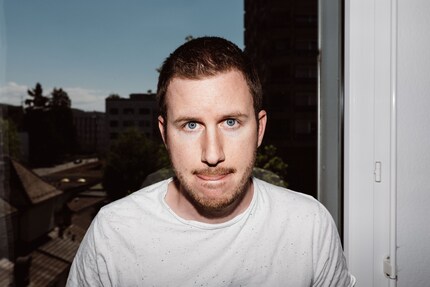
Tom, you can't fool me even with a deliberately poorly taken photo! That looks like a flash. So I assume it wasn't shot with a smartphone.
Tom's comment: "Yes exactly, I took this photo with the Nikon D810. I attached the Nikon SB-700 flash unit to the camera. The frontal direct flash is not always appropriate, but I think it has something honest about it. It's direct, doesn't sugarcoat anything. Unfortunately, this expression really shows something real about me: when I'm engrossed in something, I often press my tongue against my lower lip."
Shooting data: Nikon D810, 1/200 sec, f/9, 50 ISO, focal length 35 mm. For better comparability of the image section, I convert all focal length specifications to full format.
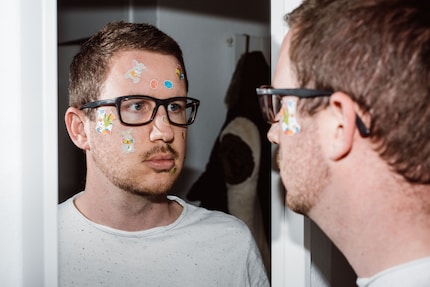
Very nice. I like the idea. I also rule out a smartphone here, because then the profile in the foreground wouldn't be so blurred.
Tom confirms this: "Same camera and flash setup as the first picture. But now I've photographed myself sideways over my shoulder in a mirror. The stickers are intended to show that you shouldn't always take yourself too seriously."
Shooting data: Nikon D810, 1/200 sec, f/5.6, 50 ISO, 50 mm.
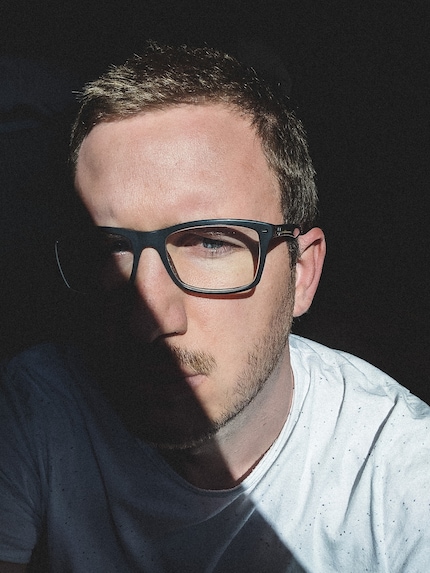
I like the black background. The camera masters the harsh contrasts with aplomb. I know that smartphones have made great progress in this respect, but I'm still guessing that this is a camera with a large sensor.
As it turns out, I'm wrong. "My smartphone picture. With selfie mode, portraits like this work amazingly well. You can see the result live on the smartphone. The shadow was created with the curtain. And the background is black because there was no light. I then post-processed the photo in Lightroom. And yes, of course, my aim when editing was to make the look as similar as possible to the other pictures. Which wasn't that easy.
Recording data: Google Pixel 3, 1/3571 sec, f/1.8, 60 ISO, 28 mm.
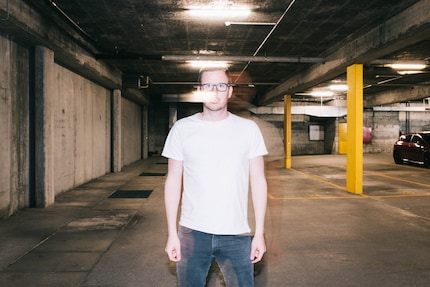
This is probably also flashed, combined with a long exposure. I don't see how that would work with a smartphone.
The resolution: "0.8 second exposure with frontal flash. Our underground car park serves as a cool urban background. After the camera flashed, I moved slightly to the left. I really like the resulting flares from the lights."
Shooting data: Nikon D810, 0.8 sec, f/9, 320 ISO, 35 mm.
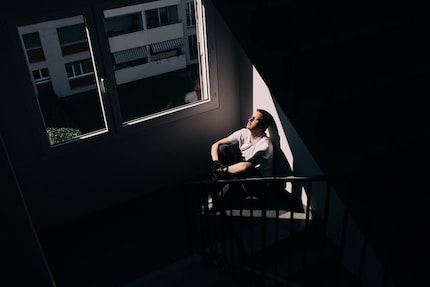
Logically, this is my smartphone tip, as I don't think all the others were. And logically, that's wrong. Of course, this is bad for the dramaturgy of the article. But it could be a smartphone picture, couldn't it? It's a wide-angle shot, which is typical for smartphones, there are no blurred areas, and I'd better not say anything more about the dynamics ...
Tom: "I took this photo from my front door. Of course, my two neighbours came by at that very moment and went back to their flats without commenting. I wonder what they were thinking? The picture was taken with the Nikon camera. The light was just perfect."
Shooting data: Nikon D810, 1/1600 sec, f/8, 320 ISO, 35 mm.
And now for my masterpieces of self-staging.
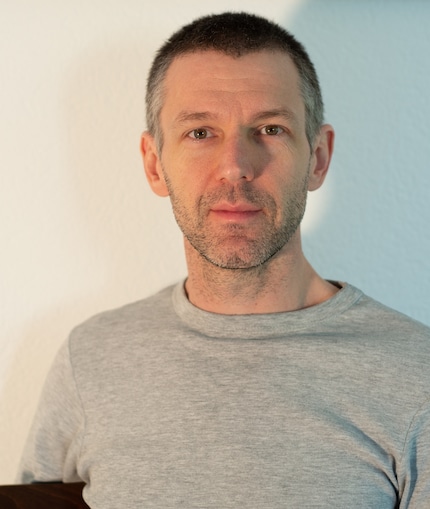
Tom seems to know exactly how I took this photo: "Made with the Nikon camera. Without flash. I recognise different light sources in your eyes. I'm guessing a living room or office lamp from your right side. You can see a shadow from your nose on the left side of your face. Based on this shadow and the shiny spot in your eye, I think that the lamp is shining on you slightly from below. I can also see a window in your left eye. If I look closely, I can see something green in the window. A tree or bush or something. I can also see this greenish light on the left side of your face in the shadow area."
I am impressed. The camera is right, the light sources too, except for the detail that it's a halogen spotlight covered with baking paper. Something like this one.
This picture is my attempt to take a normal, neutral portrait. Not easy at all. One reason for this is the self-timer. It doesn't focus when the photo is taken, but as soon as I press the shutter button. Because I'm not sitting on the chair at that moment, the camera focuses on the wall instead of the face. I therefore use manual focus here.
Shooting data: Nikon D7500, f/2.2, 160 ISO, 75 mm.
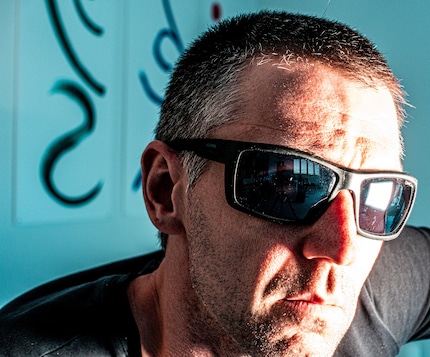
Tom speculates: "Shot with the Nikon camera. I suspect that you deliberately set the white balance of the camera to a bluish colour and illuminated your face with a yellowish LED. Or Photoshop. I can also see from your glasses that you own a lot of books and probably enjoy reading. I can't see your guitar collection, but I can see a piano. You probably increased the clarity in post-processing."
I hold the very bright and hot 400-watt halogen spotlight in front of my face for this picture to create a special light. This is not possible without sunglasses. To emphasise the effect of the harsh light, I actually turned up the clarity in Lightroom. The "Structure" slider too. The colours do not come from the white balance, but from the calibration à la Orange & Teal. I hadn't realised that the sunglasses would reveal details of my flat in full resolution. So watch out: If you publish selfies with sunglasses, take a close look and reduce the resolution if necessary!
Shooting data: Sony RX100 III,1/100 sec, f/2.8, 125 ISO, 53 mm.
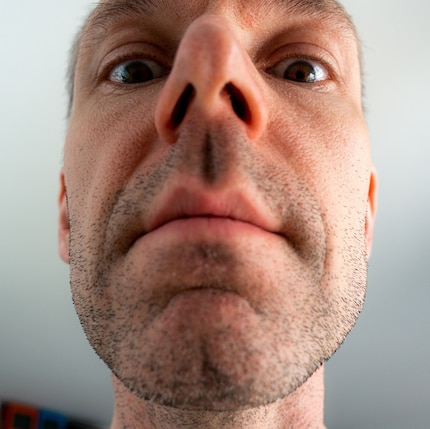
Tom doesn't like wide-angle portraits. "A nice grey-white gradient in the background." He doesn't say anything else about it.
For this photo, I turned the screen of the compact camera 180 degrees so that I could see myself taking the picture. In terms of geometry, it could well be a smartphone picture, but the blurred areas probably gave me away. In any case, Tom didn't fall for it.
Shooting data: Sony RX 100 III, 1/100 sec, f/2.5, 125 ISO, 24 mm.
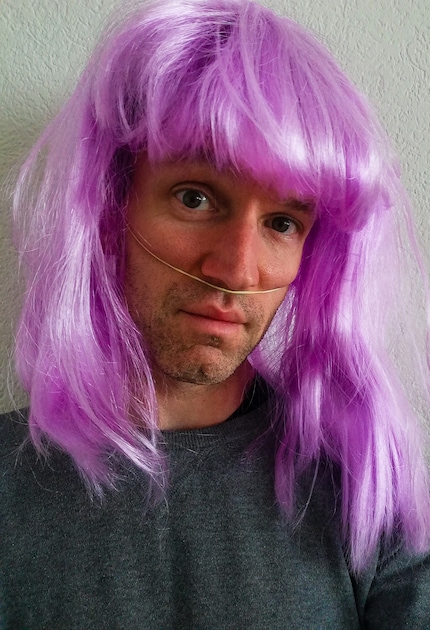
Here Tom taps on the smartphone shot because everything is in focus. And he taps correctly. Otherwise: "Natural light. I really like the composition and the orientation of the head."
Original aim: to distort my face in a similar way to what I saw at Wes Naman. But the very first rubber reminds me of the sprayed-on lips of wannabe stars and I decide to change my plan. In the photo, another invisible rubber band pulls my eye up so that I look a little friendlier.
Recording data: Huawei P20 Lite, 1/35 sec, f/2, 200 ISO, 27 mm.
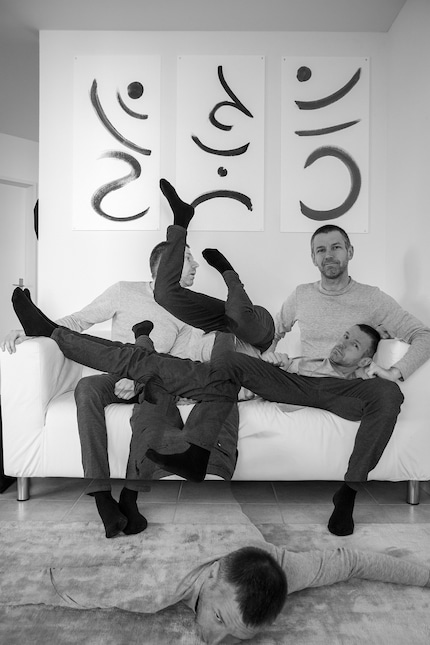
Tom's comment: "Art on the sofa, on the floor and on the wall. Cool art project. I think you stitched several photos together in photoshop and converted them to black and white."
My Nikon camera has a function called multiple exposure, that's what gave me the idea. In fact, you could also combine individual shots in Photoshop. I use a remote shutter release and of course a tripod. I'm already satisfied with the first attempt.
Shooting data: Nikon D7500, 1/40 sec, f/3.8, 100 ISO, 27 mm
Like most photographers, Tom feels much more comfortable behind the camera than in front of it. "The self-portraits took me a lot of effort," he admits. For me, on the other hand, the desire to goof around is always greater than my shyness.
What frustrated us both equally: The fact that the self-timer focuses right at the start. Tom held one hand where his face should be a few seconds later when he took the photo. This is of course imprecise and takes several attempts. The only clean solution I know of is remote control via smartphone app. But until the camera has finally established a connection with the smartphone, I always have to utter a number of unseemly expressions. I really only use the app in an emergency. Tom's Nikon D810 doesn't even have Wi-Fi yet. Tom, you need a new camera!
Do you have the same problem with the self-timer on your cameras? How do you solve it?
And of course there's the all-important question:
Who takes the better self-portraits?
The competition has ended.
My interest in IT and writing landed me in tech journalism early on (2000). I want to know how we can use technology without being used. Outside of the office, I’m a keen musician who makes up for lacking talent with excessive enthusiasm.
Practical solutions for everyday problems with technology, household hacks and much more.
Show all